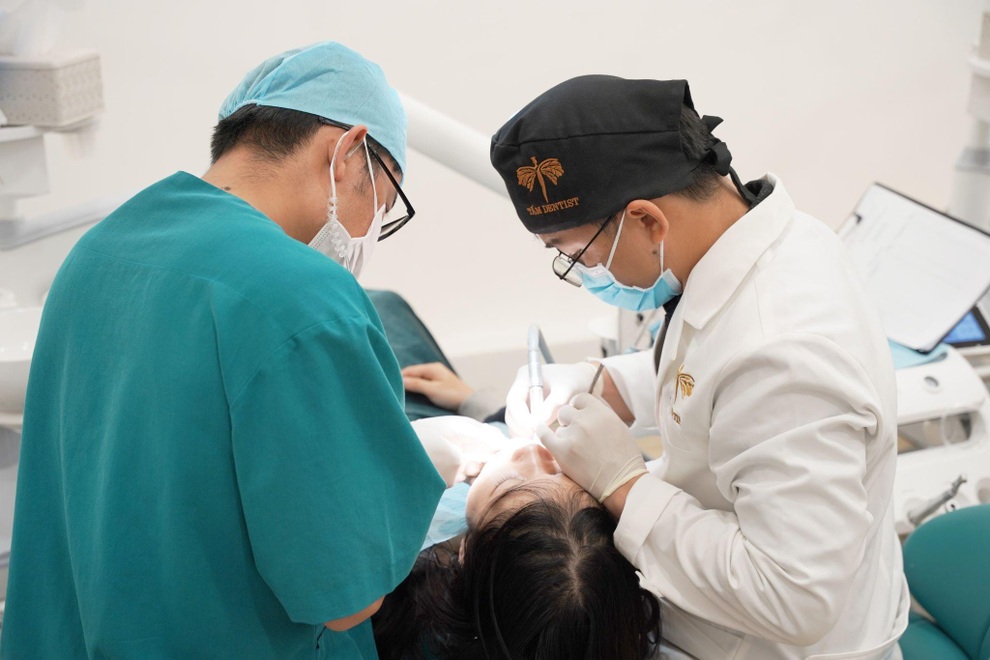Improper oral hygiene
Dr. Nguyen Minh - Tam Dentist Dental System, said that wearing orthodontic appliances makes oral hygiene more complicated. If teeth are not properly cared for, food can easily get stuck, creating conditions for bacteria to grow, leading to tooth decay, gingivitis, periodontitis or gingival hypertrophy.
These problems not only affect oral health but also disrupt the orthodontic process.
According to Dr. Minh, people with braces need to follow the dentist's hygiene instructions. Brush your teeth at least three times a day. Note that how many times you brush your teeth a day is not as important as brushing your teeth correctly and using the right toothbrush.

Brush your teeth after every meal with a soft-bristled toothbrush, brushing carefully around the braces at a 45-degree angle (Photo: Getty).
People with braces should use interdental brushes, dental floss or water flossers to clean hard-to-reach areas. Rinsing with saline or alcohol-free mouthwash helps reduce the risk of infection.
Chewing incorrectly
Diet also directly affects the effectiveness of braces. According to experts, eating foods that are too hard or sticky or drinking drinks that are too hot can cause the braces to come loose, the archwire to deform, and interrupt treatment.
Research from the University of Michigan shows that the group of patients who maintain a diet rich in protein, soft vegetables and limit sticky sweets have a 30% lower rate of broken braces than the group with an uncontrolled diet.
This shows the important role of diet in the orthodontic process.
However, many people with braces have the habit of not chewing, so they only eat soft, liquid foods. Eating less leads to less activity of the chewing muscles and weight loss, causing sunken cheeks.
Therefore, you need to chew a lot, eat a variety of foods (except tendons, cartilage, bones), and should not be too restrictive in losing weight, which can lead to a sunken face.

You should eat soft, easy-to-chew foods such as porridge, soup, rice and vegetables, chopped meat and fish, yogurt, especially in the early stages when you are not used to braces (Photo: Getty).
Do not wear intermaxillary elastics and retainers
Intermaxillary elastics play an important role in correcting the bite, but many people ignore them because they find them cumbersome. Similarly, after braces are removed, if the retainer is not worn as prescribed, the teeth can easily shift back, losing the results of many years of braces.
Research published in the American Journal of Orthodontics and Dentofacial Orthopedics confirms that 80% of patients who do not wear their retainers as prescribed experience re-displacement of their teeth within 2 years. Therefore, retainers are considered the “last line of defense” to protect orthodontic results.
Choose the wrong doctor
Another mistake is to believe in “cheap” advertising or choose an inexperienced doctor. An inappropriate treatment plan can cause teeth to move in the wrong direction, misalign the bite, and even damage the gums and tooth roots.
The World Federation of Orthodontists (WFO) 2020 report shows that 30% of orthodontic failures are related to treatment at facilities with insufficient expertise. Therefore, choosing a reputable dental clinic with a doctor with certification and clinical experience is a decisive factor.

According to Dr. Nguyen Minh, you should choose a reputable dental clinic with highly qualified doctors and clinical experience (Photo: BSCC).
Skip follow-up appointments
Braces are a process that lasts from 1 to 3 years, depending on the condition of the teeth. However, many people skip their appointments due to busy schedules or impatience when they do not see clear results. This makes it impossible for the doctor to adjust the pulling force in time, slowing down or distorting the progress of tooth movement.
A study by the University of Tokyo (2019) that followed more than 500 orthodontic patients showed that those who fully adhered to their appointment schedule had a success rate of over 90%, while the group that missed more than 3 follow-up visits had a risk of extending treatment time by 8-12 months.
The orthodontic journey requires the person wearing braces to be patient and follow the doctor's instructions properly so that the braces time will not be prolonged and the desired results will be achieved.
Source: https://dantri.com.vn/suc-khoe/sai-lam-khi-nieng-rang-nhieu-nguoi-viet-mac-phai-20250822133407329.htm



![[Photo] Experience at the Exhibition of 80 years of national achievements - Meaningful activity for new students](https://vphoto.vietnam.vn/thumb/1200x675/vietnam/resource/IMAGE/2025/9/10/286061b79abb4afa8961d730c9833cdd)
![[Photo] Giant pipeline leading water to West Lake, contributing to reviving To Lich River](https://vphoto.vietnam.vn/thumb/1200x675/vietnam/resource/IMAGE/2025/9/10/887e1aab2cc643a0b2ef2ffac7cb00b4)



![[Photo] Close-up of 3,790 resettlement apartments in Thu Thiem to continue auction](https://vphoto.vietnam.vn/thumb/1200x675/vietnam/resource/IMAGE/2025/9/10/be974e2058f74c9c8dc1f400124f3653)


























































































Comment (0)